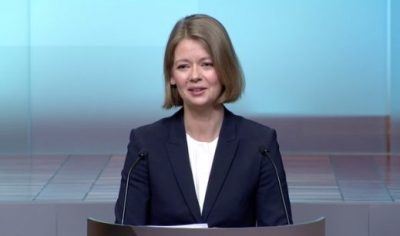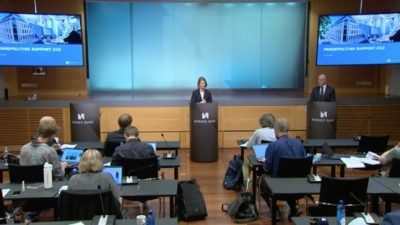NEWS ANALYSIS: Norway’s new central bank chief could finally end weeks of rampant speculation, not over whether interest rates would rise, but by how much. Ida Wolden Bache and the bank’s monetary policy committee opted to double the size of recent rate hikes, and warned that another rate increase is likely soon.

Bache has taken over her new top post as governor of Norges Bank at a time of widespread economic uncertainty, even for an economically strong country like Norway. Norway is earning more than ever on its oil and gas resources, not least because of the war in Ukraine, but also reeling from record-high electricity rates and fuel prices, along with worrisome overall inflation. Prices are rising quickly on just about everything, as they are elsewhere in the world. Even though Norway’s unemployment rate is record low, household budgets and many businesses are now under pressure from all the unusually large bills that just keep rolling in.
That prompted the central bank to raise its policy rate by half-a-point (to 1.25 percent) twice the quarter-point hikes that had become standard in recent years, if rates were raised at all. Bache (roughly pronounced “Bah-keh”) quickly noted that the monetary policy committee’s “current assessment of the outlook and balance of risks” suggests the policy rate “will most likely be raised further to 1.5 percent in August.” She even predicted a policy rate of “around 3 percent” by the summer of next year.
The goal is to stabilize inflation around the central bank’s long-time goal of 2 percent. She noted how it’s already “markedly” above that target, since core inflation is currently at 3.4 percent, while overall prices in May were 5.7 percent above the same month last year. Bache also confirmed lots of Norwegian analysts’ and economists’ predictions lately that rates will be raised more quickly than the bank itself had earlier expected.
“Prospects for a more prolonged period of high inflation suggest a faster rise in the policy rate than projected earlier,” Bache stated. “A faster rate rise now will reduce the risk of inflation remaining high.” That in turn would probably force “a sharper tightening of monetary policy” in the future.
The policy rate rise resulted in an overnight lending rate of 2.25 percent and it will prompt commercial banks and other lenders to quickly raise lending rates, especially on home mortgages. Those with savings should also see their interest rates on savings rise accordingly.
At a press conference following the rate announcement Thursday morning, Bache said she didn’t want to answer “yes” or “no” to a question over whether the half-point rise was tied to the US Federal Reserve’s recent surprise decision to raise rates by three-quarters of a point. She noted that the committee follows interest rate action abroad, but felt an increase that’s double the recent norm (instead of triple) was sufficient for now, both to try to control inflation and strengthen the currently and unusually weak value of the Norwegian currency, the krone.
It continued to trade at least initially at NOK 9.98 against the US dollar on Thursday, even though the price of Norway’s North Sea Brent crude oil remains over USD 100 a barrel. That’s surprisingly weak, given how a US dollar cost as little as NOK 6-7 when oil prices were just as high or even higher back in the 2000s. The krone hasn’t been this weak since right when the Corona crisis began and never over the past two decades.
It all reflects a huge paradox in the Norwegian economy at present. Most economists and politicians agree that it recovered quickly and well from the pandemic, and are relieved that unemployment is record low, at just 3.2 percent according to state statistics bureau SSB, or even lower by other calculations.
On the other hand, the low unemployment rate reflects labour shortages in several fields that’s forcing up wages and, in turn, creating additional costs that employers are keen to recover. Even though wages are rising, most Norwegians are seeing those pay hikes gobbled up by all the shockingly high electricity bills, among the world’s highest petrol prices at the pump and much higher prices at the grocery- and other stores. Food prices are also due to jump from July 1, when Norwegian farmers and their coops can charge even more for everything from eggs to meat and produce.

Real estate prices have also continued to rise, although housing starts and sales have begun to sink in recent months. A two-room apartment in downtown Oslo can still cost as much as NOK 6.1 million (USD 616,000) or even more, maintaining tough affordability challenges for first-time buyers who can’t rely on parental help. And then they often wind up with heavy debt, the monthly cost of which will now rise. State banking authorities at Finanstilsynet have been warning about heavy debt levels in Norway for years, and they still are.
There’s been a flood of economic outlooks for Norway lately and most predict higher prices and lower economic growth. Øystein Dørum at employers’ organization NHO thinks there’s been a “marked shift” in the economy that gives reason for less optimism. Many NHO members are struggling with higher costs and difficulty finding workers.
State welfare agency NAV, which recorded an unemployment rate of just 2 percent by its calculations in March, now thinks unemployment will rise after the summer holidays. NAV director Hans Christian Holte points mostly to higher interest rates and higher prices that will slow down the economy.
Surveys registering ordinary Norwegians’ sentiment have also showed a change from the incessant optimism of pre-Corona times, to the reassurance of the rapid Corona recovery but now, a sharp decline in economic expectations. Newspaper Dagsavisen ran a story already in late March that consumer confidence in the Norwegian economy was hitting an historic low, according to an index compiled by research firm Opinion. Fully 55 percent of those questioned thought Norway’s economy would decline, up from 31 percent in February.
By May, expectations had declined even more. That’s when the finance sector’s own trade organization (Finans Norge) released figures showing a big decline in Norwegians’ faith in both their own and the country’s economy. That was another paradox, given lots of consumer demand and low unemployment: “Most have a secure job, and many have saved money and created a good buffer during the pandemic,” noted FinansNorge‘s leader Idar Kreutzer, a former top insurance executive. “We think it has to do with high price rises, especially for energy but also food, and that interest rates will rise.”
Those are some of the same factors that are still prompting government leaders to spend more of Norway’s funds from oil revenues, also because there are still lots of crises tied to the pandemic and the war in Ukraine. Others, including former NHO leader Kristin Skogen Lund, now head of media firm Schibsted, are worried that inflation will take a lasting grip on the economy. “Even in wealthy Norway, that can mean worse household economy,” Lund told newspaper Dagens Næringsliv (DN) last month.
Prime Minister Jonas Gahr Støre has also predicted that times can “get tougher for many,” and that his government must plan for that. That’s exactly what the central bank is trying to do, too: “We understand this (Thursday’s interest rate rise) will be demanding,” Bache said, adding that “we’re raising interest now to dampen price growth later.”
newsinenglish.no/Nina Berglund

